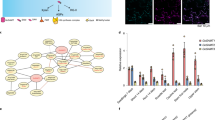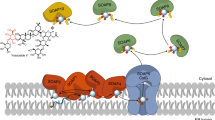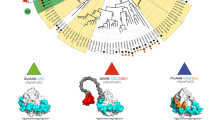Abstract
MYOINOSITOL is readily converted into uronosyl and pentosyl monomers of pectin and related polysaccharides in higher plants1,2. During this conversion, myoinositol is cleaved between carbon atoms 1 and 6 and is oxidized at carbon 1 to yield D-glucuronic acid. The latter is further converted by the plant to a number of metabolic products including pectin and hemicellulose. It remains undetermined whether this conversion is an obligatory pathway of polysaccharide biosynthesis during cell wall formation, but certain theories may be advanced about the role of this process as a source of methylated uronosyl and pentosyl residues.
This is a preview of subscription content, access via your institution
Access options
Subscribe to this journal
Receive 51 print issues and online access
$199.00 per year
only $3.90 per issue
Buy this article
- Purchase on Springer Link
- Instant access to full article PDF
Prices may be subject to local taxes which are calculated during checkout
Similar content being viewed by others
References
Loewus, F. A., Kelly, S., and Neufeld, E. F., Proc. U.S. Nat. Acad. Sci., 48, 421 (1962).
Loewus, F. A., and Kelly, S., Arch. Biochem. Biophys., 102, 96 (1963).
Plouvier, V., Chemical Plant Taxonomy, edit. by Swain, T., 313 (Academic Press, 1963).
Whistler, R. L., and Sanella, J. L., Proc. Fourth Intern. Congr. Biochem., Vienna, 1958, 1, 1 (Pergamon Press, 1959).
Hirst, E. L., Proc. Fourth Intern. Congr. Biochem., Vienna, 1958, 1, 31 (Pergamon Press, 1959).
Smith, F., and Montgomery, R., The Chemistry of Plant Gums and Mucilages (Reinhold Publ. Corp., 1959).
Aspinall, G. O., Adv. Carbohydrate Chem., 14, 429 (1959).
Northcote, D. H., Intern. Rev. Cytol., 14, 223 (1963).
Loewus, F. A., Arch. Biochem. Biophys. (in the press).
Das Gupta, P. C., and Sarkar, P. B., Text. Res. J., 24, 705, 1071 (1954).
Andrews, P., and Hough, L., Chem. and Indust., 1278 (1956).
Conrad, H. E., DuBus, R., and Gunsalus, I. C., Biochem. Biophys. Res. Comm., 6, 293 (1961).
Neufeld, E. F., and Hassid, W. Z., Adv. Carbohydrate Chem., 18, 319 (1963).
Loewus, F. A., and Kelly, S., Arch. Biochem. Biophys., 95, 483 (1961).
Albersheim, P., J. Biol. Chem., 238, 1608 (1963).
Loewus, F. A., and Kelly, S., Biochem. Biophys. Res. Comm., 7, 204 (1962).
Kindl, H., and Hoffmann-Ostenhof, O., Biochem. Z., 339, 374 (1964).
Scholda, R., Billek, G., and Hoffmann-Ostenhof, O., Z. Physiol. Chem., 335, 180 (1964).
Author information
Authors and Affiliations
Rights and permissions
About this article
Cite this article
LOEWUS, F. A Proposed Pathway for the Biosynthesis of Pectin and Methylated Uronic Acid Residues. Nature 203, 1175–1176 (1964). https://doi.org/10.1038/2031175a0
Issue Date:
DOI: https://doi.org/10.1038/2031175a0
This article is cited by
-
Identification of ononitol and O-methyl-scyllo-inositol in pea root nodules
Planta (1984)
-
Beiträge zur Zellwandforschung in der Pflanzlichen Gewebekultur
Qualitas Plantarum et Materiae Vegetabiles (1967)
Comments
By submitting a comment you agree to abide by our Terms and Community Guidelines. If you find something abusive or that does not comply with our terms or guidelines please flag it as inappropriate.



